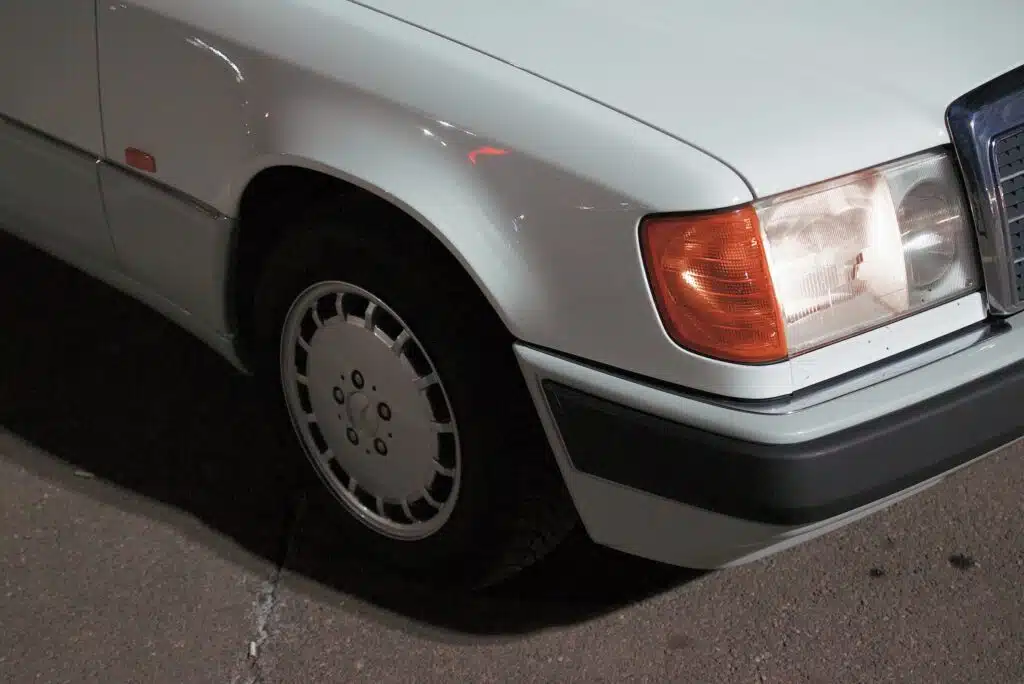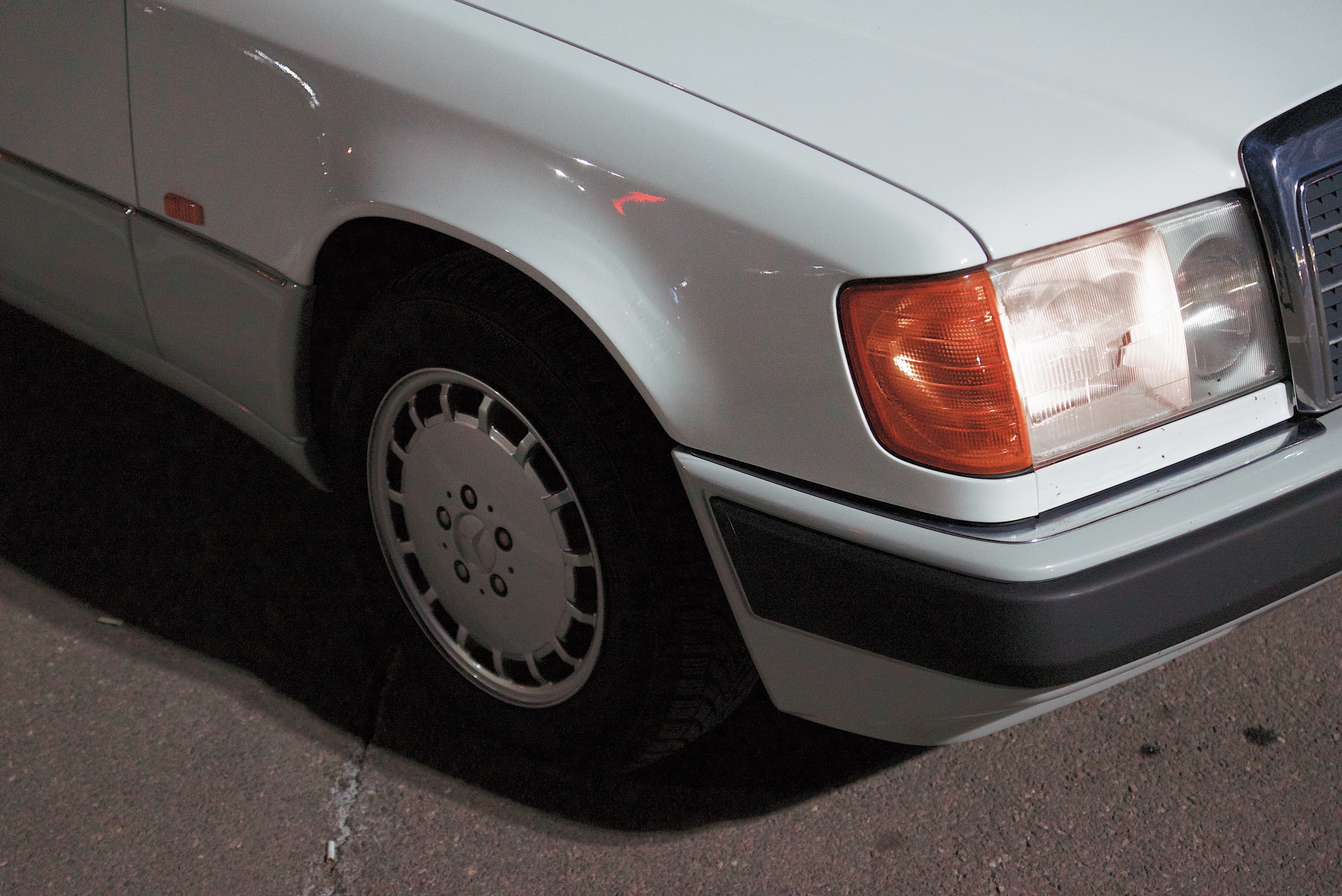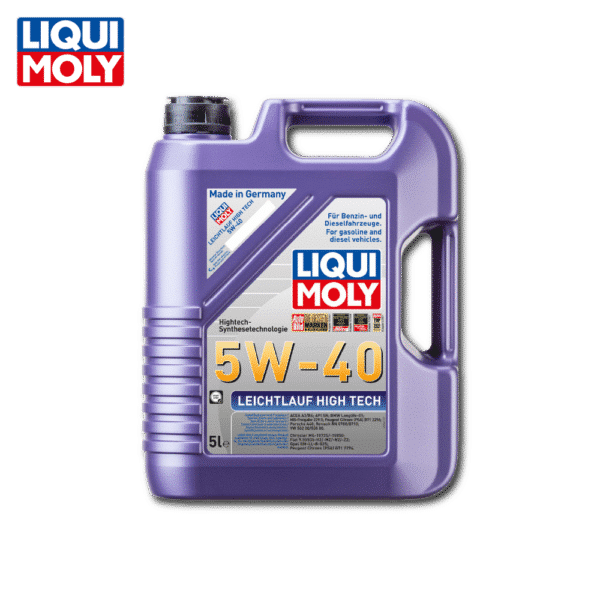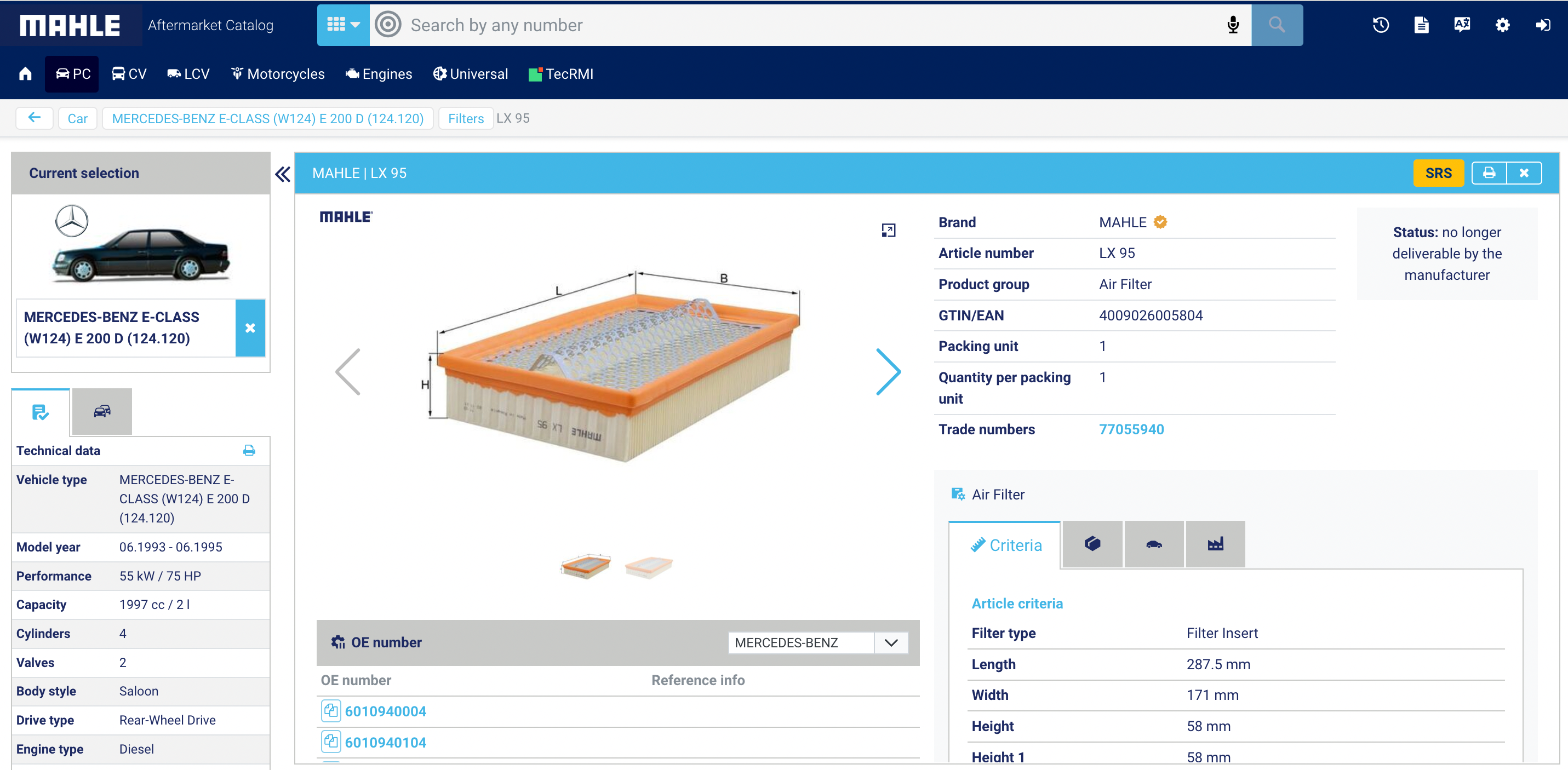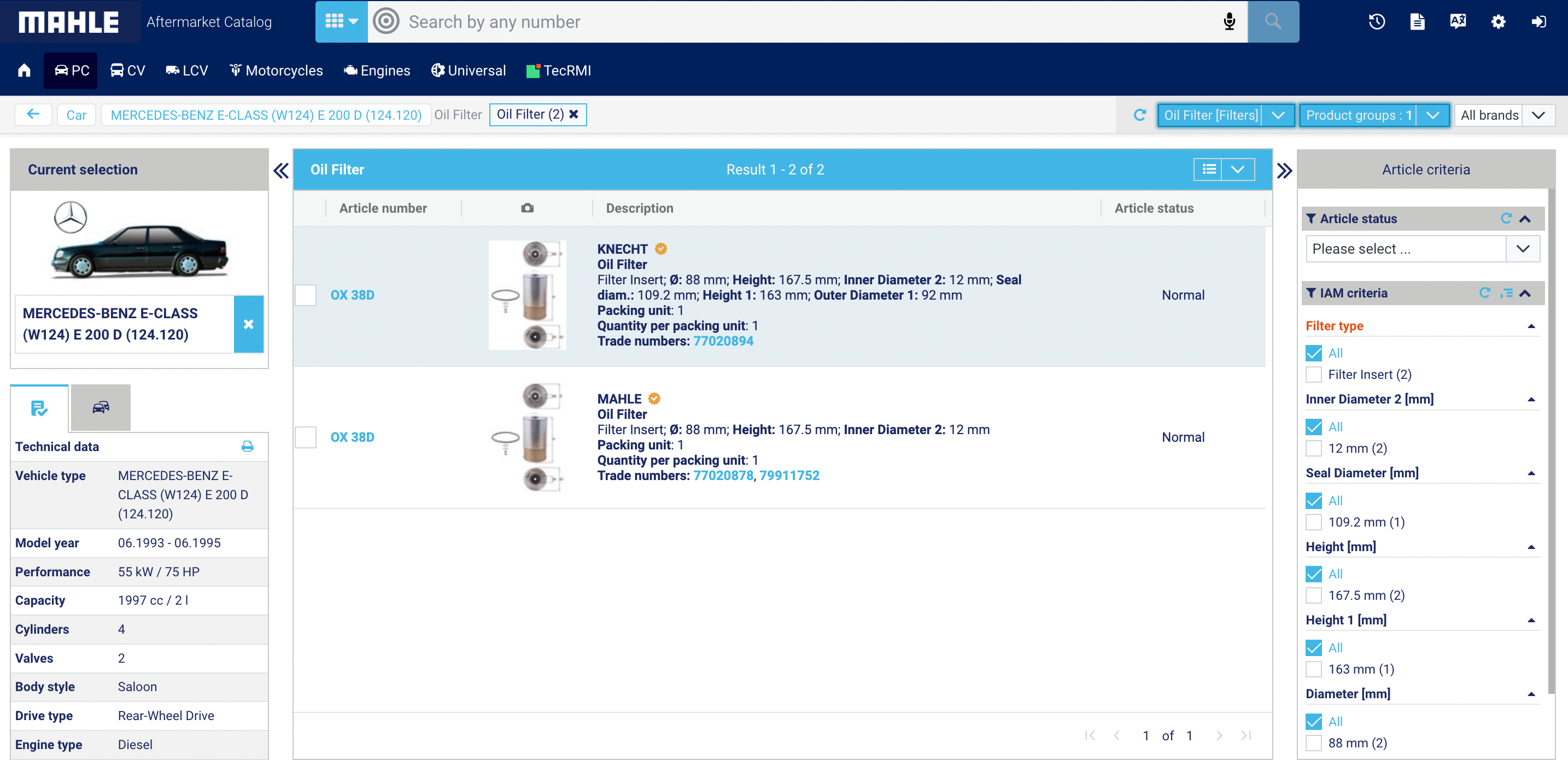The Mercedes-Benz W124 is a mid-size vehicle platform that was produced in various configurations from 1985 to 1997. This series was one of the most successful and beloved in Mercedes-Benz history, known for its durability and engineering excellence. Here’s a quick breakdown of some of the most popular W124 models:
Mercedes-Benz 300E/300E 2.6/300E 2.8/300E 4Matic: This was the standard gasoline inline-six model and was extremely popular in many markets, especially the US. The 300E 4Matic featured an all-wheel-drive system.
Mercedes-Benz 200E/260E: These were smaller displacement inline-six or four-cylinder gasoline models primarily sold in the European market. They offered a more economical option than the 300E.
Mercedes-Benz 300D/300D 2.5 Turbo/300D 4Matic: Diesel variants of the W124 were especially popular in certain markets because of their fuel efficiency and durability. The turbocharged version offered improved performance.
Mercedes-Benz E320: In 1993, Mercedes updated the W124’s naming scheme, and the 300E became the E320 to reflect the 3.2L engine displacement. The E320 came both in sedan and wagon versions and was quite popular.
Mercedes-Benz E420/E500: These were the V8 variants. The E500 (also known as the 500E in certain markets) was a collaboration with Porsche and is now considered a collector’s item. It had a limited production run, but it’s worth noting because of its high performance and unique appeal.
Coupe and Cabriolet Models (like 300CE, E320 Coupe, and E320 Cabriolet): The W124 also had coupe and convertible versions. They were less common than the sedans but still notable and sought after.
Mercedes-Benz E220: Another popular model, especially in Europe, the E220 became the more economical choice for many who still wanted the W124’s luxury and build quality but with a smaller engine for tax and fuel economy reasons.
These are just some highlights. The W124 platform had a broad range of engines and trim levels that catered to different markets and needs around the world. Some models were more prevalent in specific regions due to local preferences, economic factors, and regulations.
What does W124 stand for?
The “W124” is an internal chassis code used by Mercedes-Benz to identify a specific generation of their mid-size, executive car that was produced between 1985 and 1997.
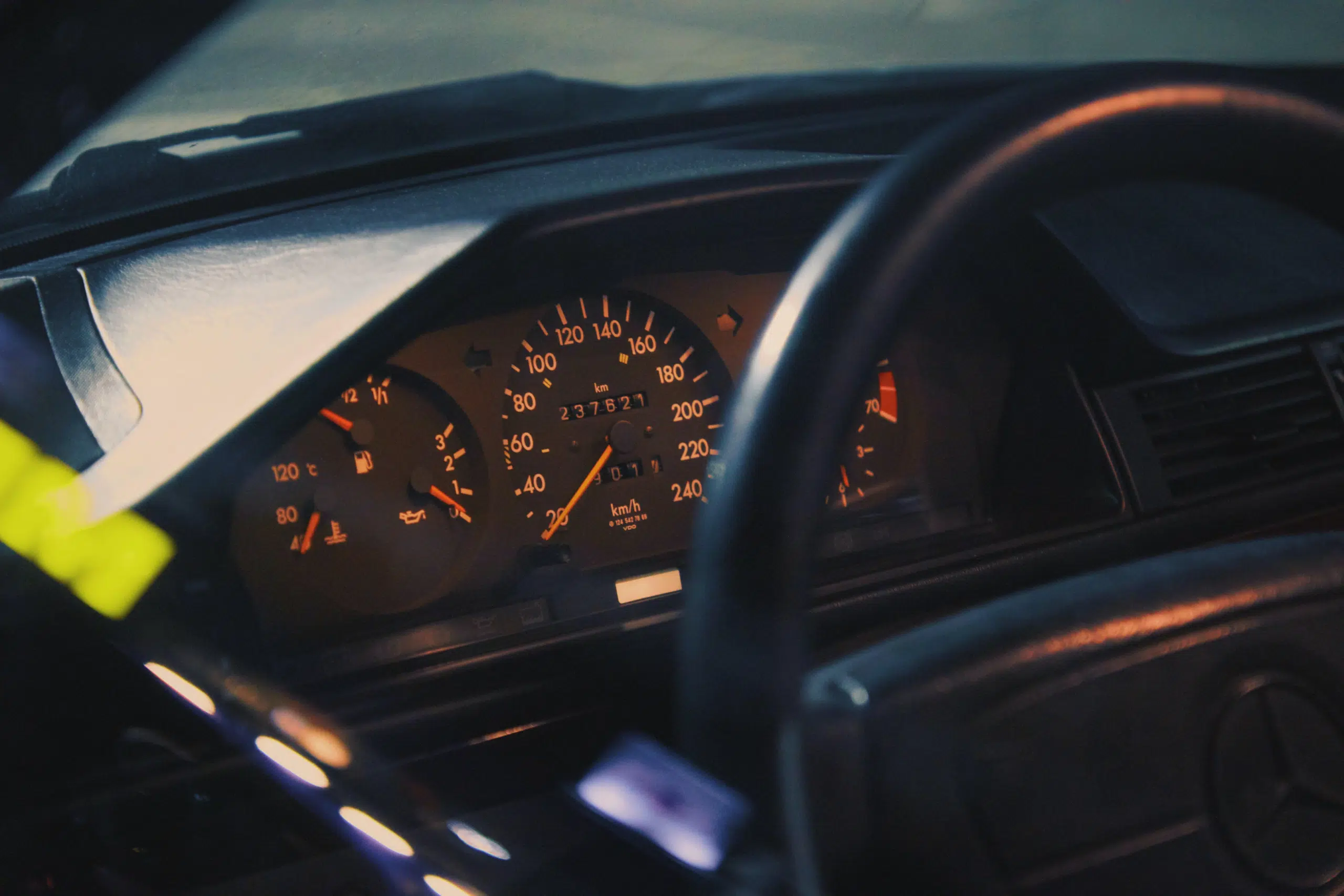
Here’s a breakdown:
W: This stands for “Wagen,” which is German for “Car.” It’s commonly used in many of Mercedes-Benz’s internal chassis designations to signify a sedan or a standard car model.
124: This is simply a unique number that identifies the specific generation or series of the car. Mercedes-Benz has a long history of using these numerical designations for their different car platforms.
So, in essence, “W124” is an internal code that Mercedes-Benz used to refer to this particular series of mid-sized cars. To the public, these cars were more commonly known as the E-Class, though they carried other model names based on engine size and other factors (like 300E or 260E) before Mercedes-Benz unified the naming convention under the E-Class banner in the early ’90s.
Get help for your car from our AI Car Expert!
What is the difference between W124 and W210?
The Mercedes-Benz W124 and W210 are both executive car series, but they come from different generations of the Mercedes E-Class lineage. Here’s a brief overview of the main differences between the W124 and the W210:
Production Years:
W124: Produced from 1984 to 1997.
W210: Produced from 1995 to 2002.
Design and Styling:
W124: Known for its boxy yet timeless design, the W124 has a distinct look with ribbed taillights (often referred to as “zebrastreifen” or zebra stripes) and a very straightforward, functional aesthetic.
W210: Introduced a more rounded, modern design, characterized by its oval-shaped headlamps, which led to the nickname “Eyes of the Alien” among enthusiasts.
Technology:
W124: While advanced for its time, the technology in the W124 is what you’d expect from the 1980s and early ’90s—robust and durable.
W210: Benefitted from advancements in automotive technology in the late ’90s. Features like stability control, GPS navigation, and side airbags became available.
Engine Options:
W124: Offered a wide range of engine options, including four, five, and six-cylinder gasoline and diesel engines, as well as a V8 in the later 500E/E500 models.
W210: Continued with a diverse engine lineup but introduced newer, more modern engines, including V6 options and a powerful V8 for the E55 AMG variant.
Build and Quality:
W124: Often hailed for its over-engineered build quality, the W124 is known for its longevity and durability.
W210: While still a high-quality vehicle, the W210 faced criticisms for some quality issues, notably concerning rust, which were not as prevalent in the W124 era.
Suspension:
W124: Used a semi-trailing arm rear suspension.
W210: Introduced a multi-link rear suspension, which improved handling and comfort.
Safety:
W124: One of the first cars to feature a frontal airbag as standard and later models had options for side airbags.
W210: Introduced more advanced safety features, including the Electronic Stability Program (ESP) and Brake Assist.
In essence, while both models are representative of Mercedes-Benz’s commitment to quality and luxury in their respective eras, the W210 reflects a more modern approach to design, technology, and safety, building upon the foundation laid by the W124.
Is the W124 engine good?
The Mercedes-Benz W124 series is renowned for its well-engineered and durable engines. Here are some key points to consider about W124 engines:
Reliability: Many W124 engines, both gasoline and diesel, are known for their long-lasting reliability. It’s not uncommon to hear of these engines surpassing 300,000 miles (around 480,000 km) with proper maintenance.
Over-engineering: Mercedes-Benz of the W124 era is often lauded for “over-engineering” their vehicles. This means that many components, including the engines, were built to standards well above what was typical or necessary, resulting in impressive longevity.
Variety: The W124 series was offered with a wide range of engine options, from fuel-efficient four-cylinder units to powerful six-cylinder and V8 engines. The diesel engines, in particular, have a solid reputation for their durability.
Maintenance: Like any car, the longevity of a W124 engine depends on regular and proper maintenance. Mercedes-Benz engines from this era were built to last, but they still require regular oil changes, filter replacements, and other routine care to operate optimally. They can be more expensive to maintain than some other vehicles, but with proper care, they can outlast many of their contemporaries.
Spare Parts Availability: Given the popularity and long production run of the W124, many parts are still available, making it relatively straightforward to maintain and repair these engines.
Performance: While the W124 engines are known more for their durability than outright performance (with some exceptions like the 500E), they offer a refined and smooth driving experience consistent with Mercedes-Benz’s luxury pedigree.
In summary, the W124 engines are generally considered to be robust, durable, and reliable, contributing to the series’ reputation as one of the best-engineered car generations from Mercedes-Benz. However, like any vintage car, prospective owners or enthusiasts should be prepared for the potential maintenance needs that come with age.
Is the W124 reliable?
The Mercedes-Benz W124 is widely regarded as one of the most reliable models ever produced by the automaker. Its reputation for durability and build quality is legendary among automotive enthusiasts and mechanics alike. Here are some points emphasizing its reliability:
Over-engineering: The W124 is often cited as an example of Mercedes-Benz’s “over-engineering” philosophy during its era. The car was designed and built to standards that exceeded typical benchmarks, which has contributed to its lasting durability.
Robust Materials: Many of the components in the W124, from the engine to the interior fittings, were made of high-quality materials that have stood the test of time.
Longevity: It’s common to find W124s with well over 200,000 miles (about 322,000 km) still running smoothly. Especially the diesel variants are known to clock even higher mileages.
Simple Electronics: Compared to contemporary vehicles, the W124 has fewer electronics, which means there are fewer components to fail. When the car does have electronic components, they are typically robust and straightforward.
Maintenance: Like any vehicle, the W124 requires regular maintenance to stay reliable. Its robust build quality means that with consistent care, it remains dependable. However, neglect can lead to issues, as with any car.
Parts Availability: Due to the popularity and long production run of the W124, many parts are still available. This accessibility helps keep older models on the road.
Known Issues: Like all vehicles, the W124 has some known issues. For instance, certain models can develop rust in specific areas, like the wheel arches and undercarriage. But these concerns are well-documented, and many enthusiasts know how to address or prevent them.
In summary, the W124 is considered highly reliable, especially when maintained properly. However, as with any older vehicle, prospective buyers or current owners should be aware of potential age-related issues and address them proactively.
W124 Maintenance and Common Engine Problems
The Mercedes-Benz W124 is renowned for its durability and engineering prowess, but like any car, especially one of its age, it comes with its own set of maintenance requirements and potential issues. Here are some general maintenance tips and commonly reported engine problems for the W124:
Maintenance:
1. Regular Oil Changes: To ensure longevity, it’s vital to change the engine oil and filter every 3,000 to 5,000 miles (4,800 to 8,000 km) for mineral-based oils or upwards of 7,000 miles (11,200 km) for synthetic oils.
2. Coolant: Regularly check and replace the coolant, especially given the age of many W124 models.
3. Transmission Fluid: Regularly check and change the transmission fluid and filter.
4. Air Filter: Replace the air filter at recommended intervals to ensure optimal engine breathing and efficiency.
5. Fuel Filter: Replace the fuel filter every 20,000 to 40,000 miles (32,000 to 64,000 km) to ensure clean fuel delivery to the engine.
6. Spark Plugs: For gasoline engines, inspect and replace spark plugs as necessary.
7. Timing Belt/Chain: Check the timing belt or chain (depending on the engine) for wear and replace it at the manufacturer’s suggested intervals.
Common Engine Problems:
1. Wiring Harness Deterioration: Some W124 models, especially those produced in the early to mid-1990s, had biodegradable wiring harnesses that can deteriorate over time. This can cause various electrical issues and should be addressed promptly.
2. Head Gasket Issues: Certain six-cylinder engines can experience head gasket leaks. This can lead to oil or coolant leaks visible on the side of the engine block.
3. Diesel Engine Glow Plugs: On diesel models, glow plugs can fail, leading to hard starts or rough idling, especially in cold weather.
4. Oil Leaks: Given the age of these cars, oil leaks can develop from various places, such as the valve cover gasket, oil pan gasket, and front/rear main seals.
5. Fuel Distributor Issues: On models with the CIS-E fuel injection system, the fuel distributor can become a problem, leading to rough idling, poor throttle response, or stalling.
6. AC System: The air conditioning system, particularly the evaporator, can fail and can be labor-intensive to replace.
7. Rust: While not an engine problem, one of the notable issues with older W124s, especially in regions with harsh winters or high humidity, is rust. Common areas include the wheel arches, door sills, and the undercarriage.
It’s important to remember that while these are common problems reported by some owners, not every W124 will experience these issues. Regular maintenance, timely inspections, and addressing minor issues before they escalate can significantly improve the longevity and reliability of a W124. Always consult with a Mercedes-Benz specialist or trusted mechanic familiar with the W124 for specific guidance.
How to change the engine oil of a W124?
Changing the engine oil of a Mercedes-Benz W124 is a fundamental maintenance procedure that can be done with some basic tools and a bit of time. Here’s a general step-by-step guide:
Tools and Materials Needed:
– Jack and jack stands (or a vehicle lift)
– Oil filter wrench or tool
– Drain pan
– New engine oil (consult the owner’s manual or a trusted source for the correct type and quantity)
– New oil filter (specific to your W124 engine model)
– Gloves and safety goggles
– Wrench or socket set
Procedure:
1. Safety First: Ensure the car is on a level surface. Wear safety goggles and gloves.
2. Warm Up the Engine: Start the car and let it run for a few minutes. This will allow the oil to warm up, making it flow more easily when draining.
3. Lift the Car: If necessary, jack up the front of the car and secure it safely with jack stands. Make sure it’s stable before you get under it.
4. Drain the Oil:
– Locate the oil pan under the engine.
– Position the drain pan beneath the oil pan’s drain plug.
– Using the appropriate wrench, carefully remove the drain plug and allow the old oil to flow out into the drain pan. Be cautious, as the oil might be warm.
– Once fully drained, replace the drain plug and tighten it securely. Do not over-tighten, as this can strip the threads.
5. Replace the Oil Filter:
– Using an oil filter wrench or tool, unscrew the old oil filter. It’s a good idea to place the drain pan below the filter location as some residual oil may spill out.
– Before installing the new filter, lightly coat the rubber gasket on the top of the filter with fresh engine oil.
– Screw in the new oil filter by hand. Once the gasket makes contact, give it another 3/4 turn. Do not over-tighten.
6. Add New Oil:
– Open the hood and locate the engine oil filler cap.
– Remove the cap and, using a funnel, pour the new engine oil into the engine. Be sure not to overfill and only use the quantity specified for your specific W124 model.
– Replace the filler cap securely.
7. Check Oil Level and Start the Engine:
– Lower the car from the jack stands if you had raised it.
– Start the engine and let it run for a few minutes. Check for any leaks under the car.
– Turn off the engine and wait a few minutes to allow the oil to settle. Then, check the oil level using the dipstick to ensure it’s at the correct level.
8. Dispose of Old Oil and Filter Properly: Do not dump old oil in the environment. Many auto parts stores or waste disposal facilities will accept used engine oil and filters for recycling.
Regularly changing the oil is crucial for the longevity and health of your W124’s engine. Always refer to the car’s owner’s manual or a trusted repair guide for any model-specific details or specifications.
What is the best engine oil for W124?
The Mercedes-Benz W123 is a predecessor to the W124 and was produced between the mid-1970s and the mid-1980s. The recommended engine oil for the W123 varies depending on the specific engine, the climate you live in, and the type of driving you do. However, here are some general guidelines:
Engine Type:
For diesel engines (like the 240D, 300D), many enthusiasts and mechanics recommend a diesel-specific engine oil like Rotella T4 15W-40 or Delo 400 15W-40. These oils contain the necessary additives to handle the soot and other by-products of diesel combustion.
For gasoline engines (like the 230E, 280E), a high-quality 10W-40 or 15W-40 mineral or semi-synthetic oil is often recommended.
Climate:
For colder climates, you might consider a lighter oil like 10W-30 to ensure the oil remains fluid during low temperatures.
For warmer climates, 15W-40 can be a good choice as it won’t thin out too much in higher temperatures.
Age and Condition:
For engines with higher mileage or those that have not been well-maintained, you might consider using high-mileage oils that are formulated with additives to rejuvenate old seals and reduce oil consumption.
Driving Style and Usage:
If you’re driving the car very infrequently and it’s mostly sitting, a mineral oil might be sufficient.
If you drive the car regularly or put it under more strenuous conditions, a semi-synthetic or even full synthetic (though not always necessary for these older engines) can offer better protection.
Oil Change Intervals:
With mineral oils, consider changing the oil every 3,000 to 5,000 miles (4,800 to 8,000 km).
For semi-synthetics or synthetics, you can stretch this interval a bit longer, but given the age of most W123 models, more frequent changes can be beneficial.
Zinc Additives:
Older engines like those in the W123 series can benefit from engine oils with a higher zinc content (ZDDP), which provides added protection to the camshaft and lifters. Some classic car engine oils contain elevated zinc levels for this purpose.
Always check the owner’s manual or consult with a Mercedes-Benz specialist for specific recommendations tailored to your car’s engine and condition. And remember, the brand of oil can also make a difference; always opt for reputable brands to ensure quality.
What is the best engine oil from LIQUI MOLY for W124?
Liqui Moly is a reputable German brand known for its high-quality lubricants, including engine oils. When it comes to selecting the best Liqui Moly engine oil for a Mercedes-Benz W124, the choice largely depends on the specific engine variant, climate, and driving conditions. However, here are some general Liqui Moly oil recommendations for the W124:
-
LIQUI MOLY Leichtlauf High Tech 5W-40£19.89 – £48.64
1. Liqui Moly Leichtlauf High Tech 5W-40: This is a versatile fully synthetic oil suitable for year-round use in many vehicles, including the W124, especially in moderate climates. It provides excellent protection and performance.
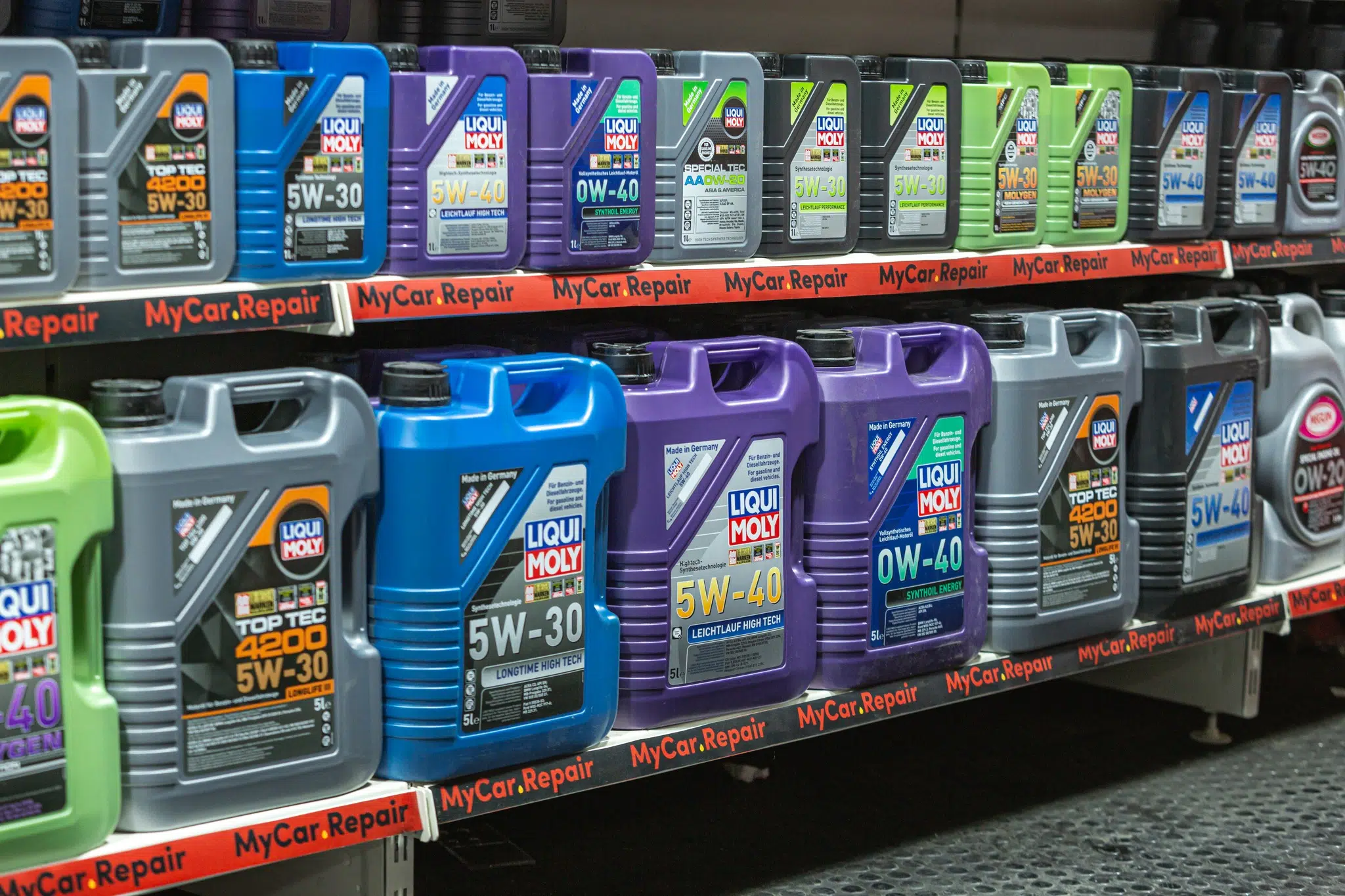
2. Liqui Moly Diesel High Tech 5W-40: For diesel variants of the W124, such as the 300D, this oil is formulated to handle the demands of diesel engines, offering excellent lubrication and protection.
3. Liqui Moly Molygen New Generation 5W-40: This is a modern synthetic oil with unique friction-reducing properties. It’s also fluorescent green, allowing you to easily spot leaks using a UV light. This oil can be used for both gasoline and diesel W124 models.
4. Liqui Moly Classic 20W-50: Designed specifically for older and classic cars, this mineral oil provides the protection that older engines, like those in the W124 series, need. Its formulation includes higher levels of zinc (ZDDP) for added protection against wear.
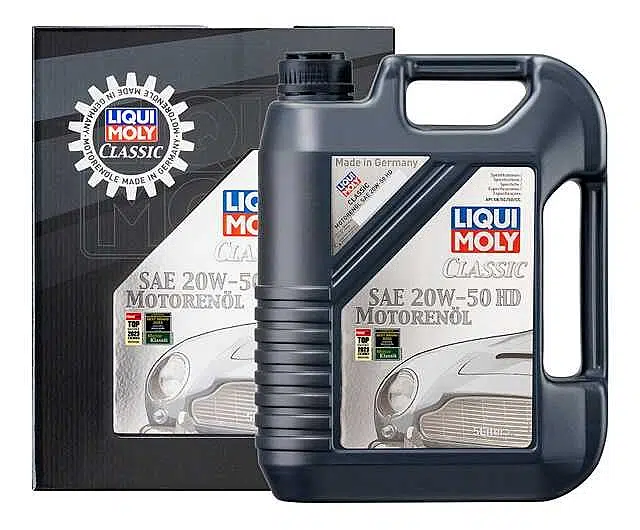
5. Climate Consideration: If you live in a colder climate, the 5W-40 variants provide better cold start protection. If you’re in a hotter climate, and especially if the car runs a bit on the warmer side, a thicker oil like the 20W-50 can be beneficial.
Remember always to pair the engine oil with a high-quality oil filter when performing an oil change. Moreover, the oil’s viscosity and type should match the manufacturer’s specifications, especially if the vehicle is still under warranty (though this would not apply to a classic car like the W124).
Lastly, regardless of the specific oil you choose, regular oil changes are essential to maintaining the engine’s health and longevity. Always refer to the car’s owner manual or consult with a Mercedes-Benz specialist for specific guidance tailored to your vehicle’s engine and condition.
Which is the best gearbox oil for a W124?
Choosing the correct gearbox oil (also known as transmission fluid) for a Mercedes-Benz W124 is crucial for the transmission’s performance and longevity. The W124 was produced with various transmissions, both manual and automatic, over its production years.
Here are some general recommendations:
For Automatic Transmissions:
1. Mercedes-Benz Approved Fluids: Always start by looking for transmission fluids that meet the Mercedes-Benz specification. For many older Mercedes automatic transmissions, the recommended specification is MB 236.10.
2. Liqui Moly ATF 1200: This is a popular choice among Mercedes-Benz enthusiasts. It’s suitable for many older Mercedes automatic transmissions and fits for MB 236.10, MB 236.11, MB 236.2, MB 236.5, MB 236.6, MB 236.7, MB 236.9, MB 236.91

3. Febi Bilstein ATF: This is another transmission fluid often recommended for older Mercedes transmissions, known for its quality and compatibility.
4. Valvoline Dexron III/Mercon: This is a widely available transmission fluid that can be suitable for older Mercedes-Benz automatic transmissions.
For Manual Transmissions:
1. Mercedes-Benz Manual Transmission Fluid: Ideally, using the OEM fluid is a good choice. Check for the specific fluid type in your owner’s manual or through a Mercedes dealer.
2. Liqui Moly GL4 75W-85: Suitable for many manual transmissions in older vehicles, this fluid provides good protection and smooth shifting.
When selecting a gearbox oil, always ensure it meets the required specifications for your specific transmission. The W124’s different models and production years might have different requirements, so always consult the owner’s manual or a trusted Mercedes-Benz specialist for guidance.
Also, it’s essential to replace the transmission fluid at the recommended intervals and always check for signs of contamination or degradation. Proper maintenance of the transmission, combined with the right fluid, can significantly extend the life of the transmission.
Which is the best coolant for W124?
When selecting a coolant for the Mercedes-Benz W124, it’s essential to choose one that meets Mercedes-Benz’s specifications to ensure proper cooling, corrosion protection, and compatibility with the engine and cooling system components.
For the W124, Mercedes-Benz typically recommends coolants that meet their own specifications. Here’s a guideline to help you select the right coolant:
1. Mercedes-Benz Genuine Coolant: Mercedes-Benz offers its own antifreeze/coolant, which is specifically formulated for their cars. If you’re aiming for maximum compatibility and peace of mind, the genuine Mercedes-Benz coolant is a great choice.
Liqui Moly Radiator Antifreeze KFS 11: This is an ethylene glycol-based coolant with silicates. It’s designed to meet the requirements of many European car manufacturers, including Mercedes-Benz. This coolant corresponds to the Mercedes-Benz MB 325.0 specification, making it suitable for the W124.
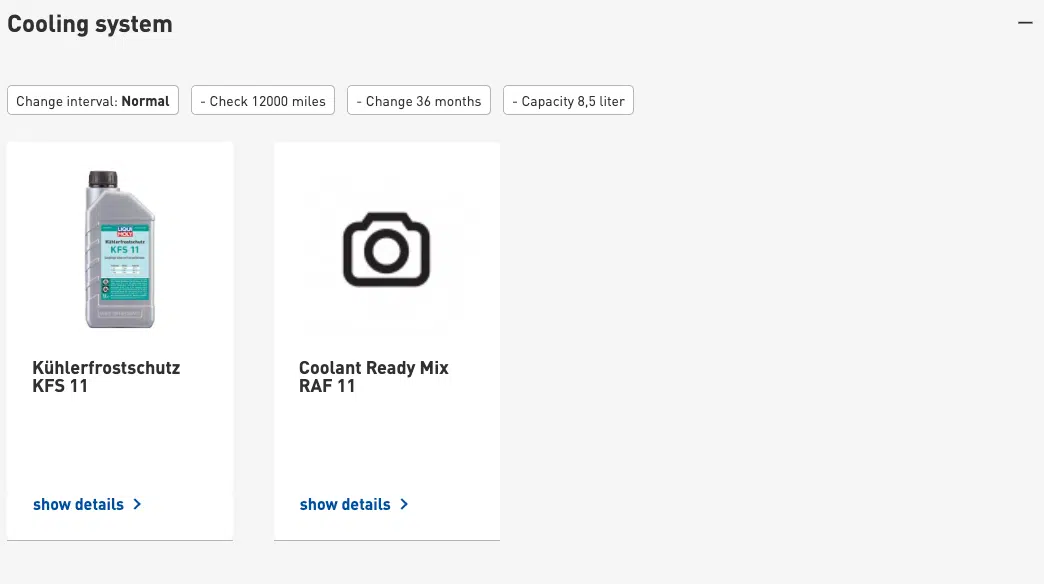
Here are some points to consider:
1. Concentration: Ensure that you mix the coolant with distilled or deionized water unless you’re purchasing a pre-mixed version. A 50/50 mix (half coolant, half distilled water) is often recommended.
2. Regular Maintenance: As with any coolant, it’s essential to replace it at the suggested intervals. Over time, the additives in the coolant can degrade, reducing its ability to prevent corrosion and maintain optimal cooling.
3. System Flush: If you’re transitioning from a different type of coolant or if the existing coolant is old and dirty, it’s a good idea to perform a complete system flush before introducing the new coolant. This ensures that the cooling system is free of contaminants and old coolant that might not be compatible with the new one.
4. Compatibility: Always ensure that any coolant you choose is compatible with the metals and materials within your car’s cooling system to prevent corrosion and unwanted chemical reactions.
It’s always a good idea to consult your owner’s manual or speak with a Mercedes-Benz specialist to ensure you’re choosing the right coolant for your specific W124 model and its current condition.
2. Zerex G-05: This is a popular aftermarket choice for many Mercedes-Benz owners. It’s a hybrid organic acid technology (HOAT) coolant, which is often recommended for European vehicles. Zerex G-05 is known to meet the MB 325.0 specification, making it suitable for many Mercedes vehicles, including the W124.
3. Pentosin Pentofrost NF: This is another quality aftermarket coolant that is suitable for Mercedes-Benz vehicles. It’s free from nitrites and amines, and it provides excellent protection against corrosion.
4. Concentration: When using these coolants, ensure you mix them with distilled or deionized water if you’re not buying a pre-mixed solution. A 50/50 mix (50% coolant and 50% distilled water) is commonly recommended, offering protection against freezing and boiling while providing the necessary corrosion protection.
5. Regular Maintenance: Ensure you flush and replace the coolant at the recommended intervals. Over time, coolants can degrade, and their protective qualities can diminish. A regular flush and refill ensure the cooling system operates efficiently and is protected from corrosion and deposits.
6. Compatibility: Always ensure the coolant you choose is compatible with the materials in your cooling system. This is especially crucial for older vehicles like the W124 to prevent corrosion and deposits.
When changing or topping up coolant, it’s essential to ensure the system is properly bled to remove any air pockets, as these can impact cooling efficiency and potentially lead to overheating. Always consult your W124’s owner’s manual or a Mercedes-Benz specialist for specific recommendations tailored to your vehicle.
Which is the correct engine air, cabin and oil filter from Mahle for W124?
Mahle is a well-known supplier of automotive parts, including filters for various applications. If you’re looking to use Mahle filters for a Mercedes-Benz W124, the exact references can depend on the specific engine variant and model year of your W124, as there were several engines offered throughout its production.
For the sake of providing a general guide, here are some common Mahle filter references for typical W124 models:
Engine Air Filter:
Generally, for many of the W124 models, you’d be looking at Mahle’s LX 95 (but always confirm based on your specific engine).
Cabin Air Filter:
The correct cabin air filter for many W124 series from MAHLE is the LA 862/S.
Oil Filter:For gasoline engines, such as the E200, you might look for Mahle’s OX 133D.For the diesel engines like the E 200 D, the filter might be Mahle’s OX 38D.
These are generalized references, and the best approach to ensure you get the correct filters is:
Vehicle Documentation: If you have an owner’s manual or service booklet, they might provide part numbers or specifications.
Supplier or Dealer: Provide your vehicle’s VIN (Vehicle Identification Number) to a Mahle dealer or supplier. They can use this information to ensure you get the correct parts.
Physical Inspection: If you have the current filters accessible, they might have part numbers printed on them. You can use these to cross-reference with Mahle’s catalog.
Always ensure that you’re getting the correct parts for your specific vehicle to ensure proper fitment and function.
How can i clean the fuel and exhaust system of a W124 with Liqui Moly additives?
Using Liqui Moly additives to clean the fuel and exhaust system of a Mercedes-Benz W124 is a common practice among enthusiasts to maintain performance and fuel efficiency. Here’s a step-by-step guide on how to do it:
Fuel System Cleaning:
1. Liqui Moly Injection Cleaner (Petrol Engines) or Diesel Purge (Diesel Engines):
Petrol Engines: Add a can of Liqui Moly Injection Cleaner to a nearly full fuel tank and then drive the car until the tank is nearly empty. This allows the additive to clean the injectors and the rest of the fuel system.
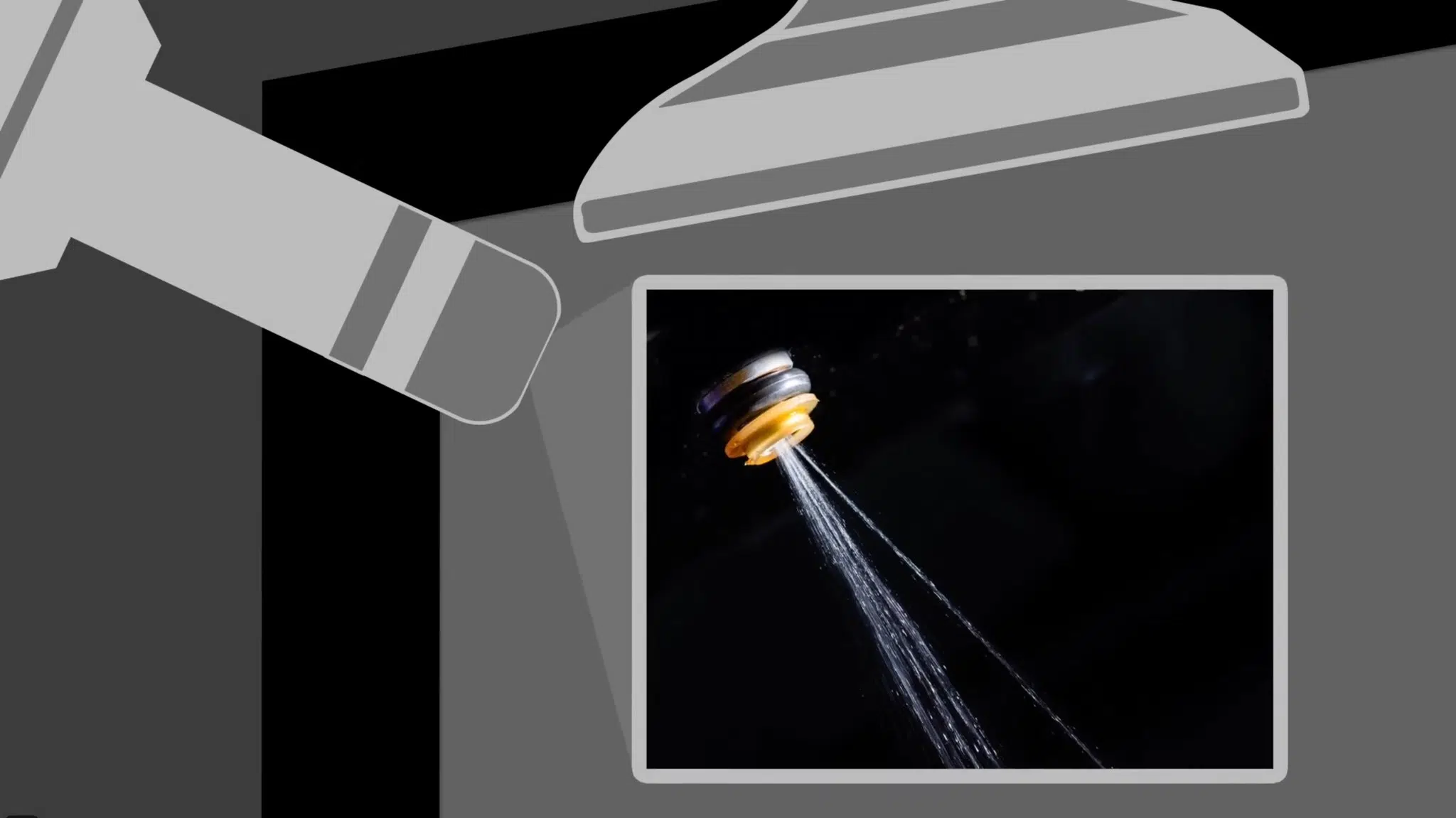
Diesel Engines: Diesel Purge is a bit different. Some users prefer to run the engine directly on Diesel Purge by disconnecting the fuel lines and running the engine on a container of Diesel Purge. This offers a more intensive clean. Alternatively, you can add it to a full fuel tank for a less aggressive clean.
2. Liqui Moly Fuel System Cleaner/Conditioner: This additive is good for regular maintenance. Add it to your fuel tank as per the instructions on the can, usually every few thousand miles.
Exhaust System Cleaning:
1. Liqui Moly Pro-Line Intake System Cleaner (Petrol Engines):
This is a spray cleaner designed to clean the intake system, valves, and combustion chamber. It requires the engine to be at operating temperature.
The cleaner is sprayed directly into the intake as the engine runs, allowing it to clean components as it’s drawn into the combustion chamber.
2. Liqui Moly Pro-Line Diesel Intake System Cleaner (Diesel Engines):
Similar to the petrol version but formulated for diesel engines. The application process is the same.
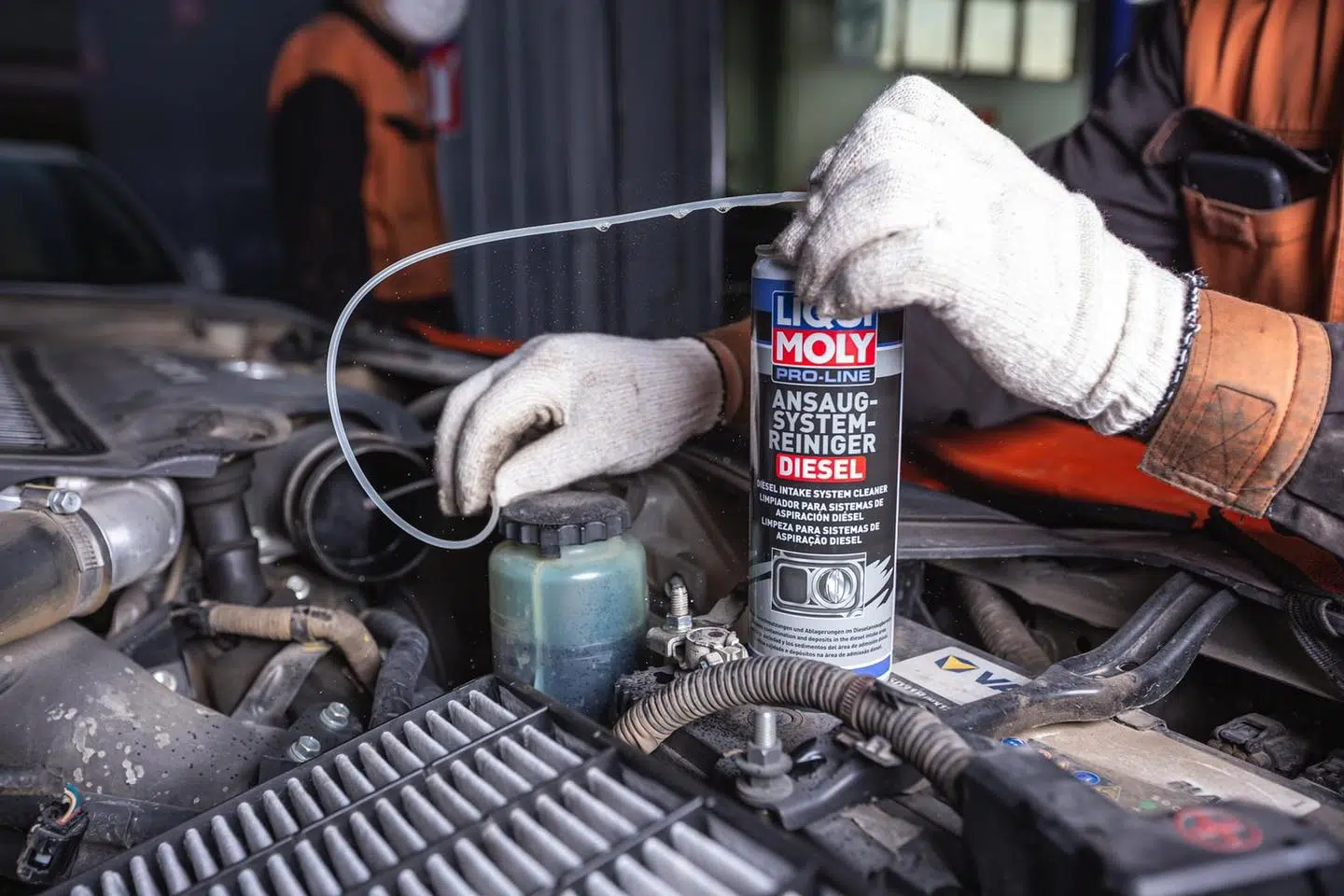
3. Liqui Moly Catalytic System Cleaner:
Add this product to a nearly empty fuel tank and then fill up. It’s designed to clean the combustion chamber and help reduce emissions, which in turn can help maintain the health of the catalytic converter.
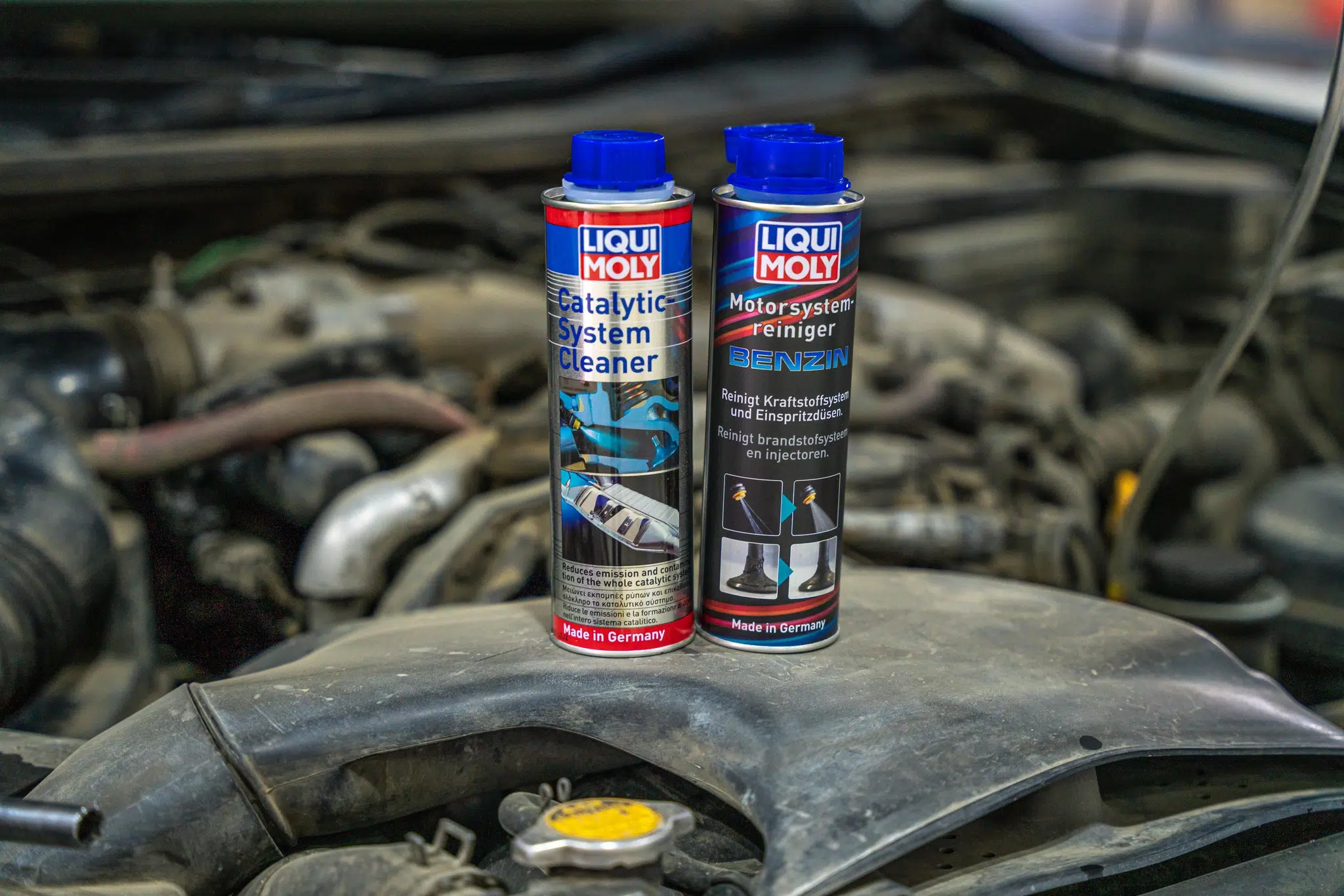
General Tips:
– Always read the instructions on the Liqui Moly additive containers. The instructions will provide guidance on how much to use and when to use it.
– For best results, try to use the car on a longer drive after adding any treatments. This ensures the additives are thoroughly circulated and can do their job effectively.
– Maintenance: After cleaning, regular use of additives can help maintain a clean fuel and exhaust system. However, don’t overuse them; follow the recommended intervals.
– Safety: Always work in a well-ventilated area, away from open flames, when working with automotive chemicals.
Lastly, while additives can be beneficial, they’re not a replacement for regular maintenance. Always ensure your W124 is serviced at the recommended intervals, and any parts that are worn out or malfunctioning are replaced. This ensures the car runs efficiently and lasts a long time.
What is the best battery for W124 Mercedes?
Selecting the right battery for your Mercedes-Benz W124 is crucial for ensuring proper performance and reliability. The W124, like most vehicles, has specific requirements in terms of size, capacity (Ah – ampere-hours), and cold cranking amps (CCA). When looking for a battery, you want to ensure it meets or exceeds the manufacturer’s recommendations.
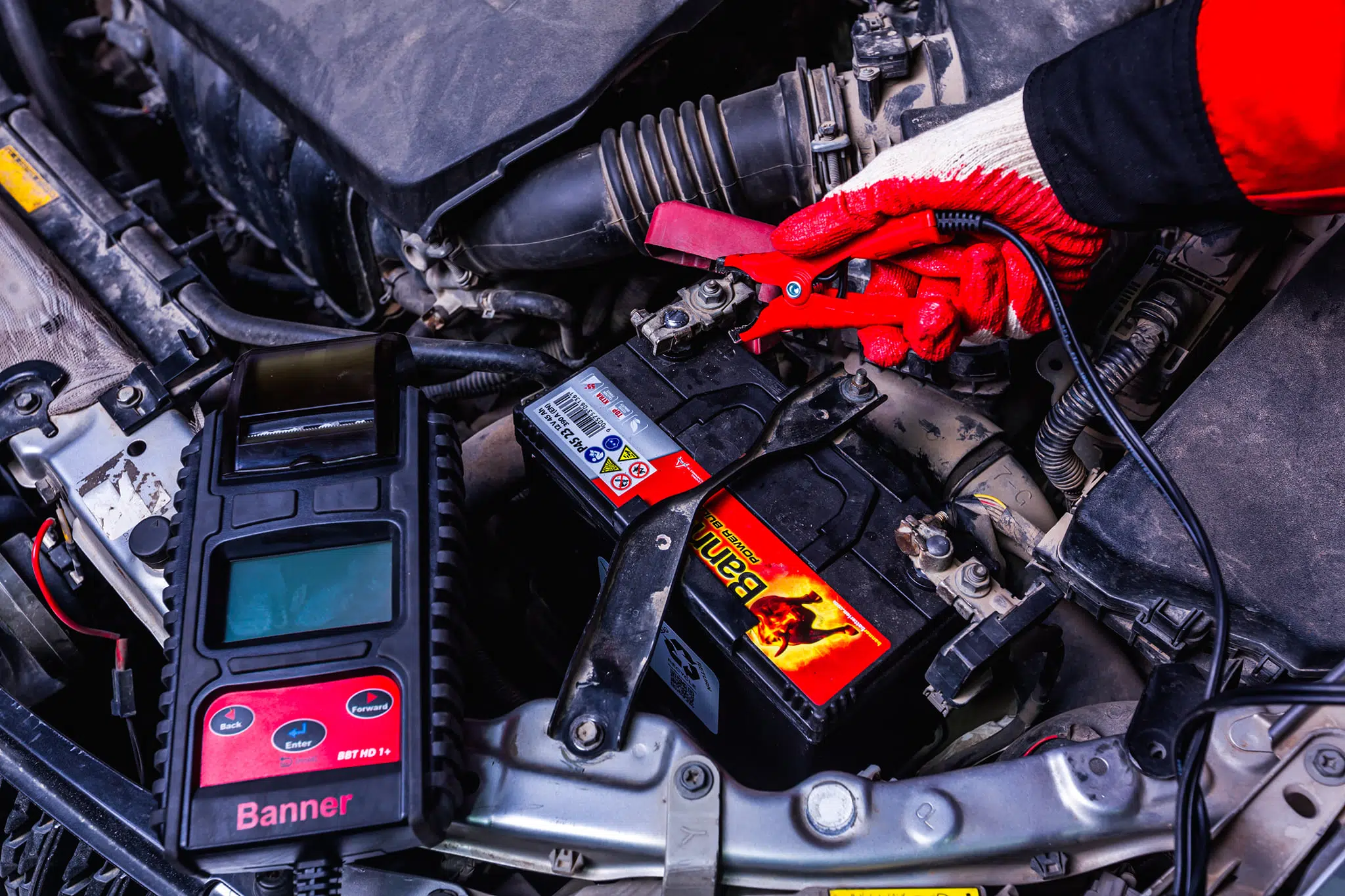
While many brands manufacture batteries suitable for the W124, some of the top-rated and commonly recommended brands include:
1. Bosch – They offer the S5 and S6 range of batteries, which are known for their longevity and reliability.
2. Varta – Another German brand, Varta batteries, especially their Silver Dynamic range, are well-regarded and offer great performance.
3. Exide – Their Excell and Premium line of batteries are often recommended for Mercedes-Benz vehicles.
4. Optima – The Optima RedTop or YellowTop batteries are high-performance and provide excellent cold cranking amps, making them suitable for climates with colder winters.
5. Mercedes-Benz Genuine Battery – Buying directly from a Mercedes-Benz dealership ensures the battery will fit and meet the performance requirements, though it might be pricier than aftermarket options.
6. BANNER Battery – Banner is a high quality OEM battery supplier based in Austria. The Power Bull PRO P77 40 is ideal for the W124
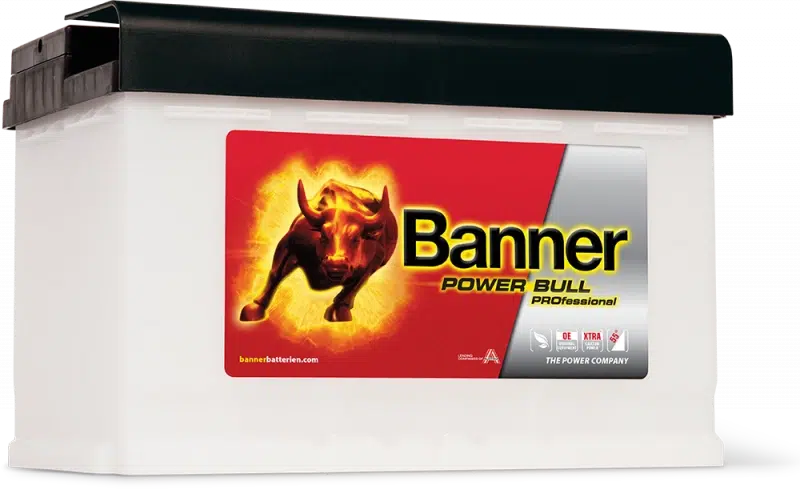
When selecting a battery:
1. Size and Fit: Ensure the battery will fit in the designated space in your W124. This involves checking the dimensions and the position of the terminals.
2. Capacity (Ah): Ensure the battery’s capacity meets or exceeds the manufacturer’s recommendation.
3. Cold Cranking Amps (CCA): If you live in a colder climate, a higher CCA rating is important. This rating indicates how well the battery can start the engine in cold temperatures.
4. Maintenance: Some batteries are maintenance-free, meaning you won’t need to add distilled water. Others require occasional maintenance.
5. Warranty: Always check the warranty period and conditions. A longer warranty often indicates a better-quality battery.
6. Age of Battery: It’s advisable to purchase a battery that’s been manufactured recently. Batteries degrade over time, even if they aren’t used. There’s usually a date code on the battery that indicates its manufacturing date.
Lastly, remember to always dispose of old batteries properly, as they contain harmful chemicals. Many retailers offer
Frequently Asked Questions about W124 Mercedes Benz:
The Mercedes-Benz W124 series is renowned for its durability, classic design, and engineering excellence. Given its popularity and long production span, several questions arise frequently among enthusiasts, potential buyers, and current owners. Here are some of the most frequently asked questions (FAQs) about the W124:
What is a W124?
The W124 is a model designation for the Mercedes-Benz E-Class vehicles produced between 1984 and 1995. They were available in various body styles, including sedans, coupes, convertibles, and wagons.
What engines were available in the W124 series?
The W124 came with a wide range of petrol and diesel engines, from four to six cylinders, including the famous OM602 and OM603 diesel engines, as well as the M102 and M104 petrol engines. The E500/500E model, developed in collaboration with Porsche, had a V8.
Are W124 cars reliable?
Yes, the W124 series is often hailed as one of the last over-engineered cars from Mercedes-Benz, known for its robustness and longevity.
What are common problems with the W124?
While reliable, the W124 can have issues like wiring harness degradation (especially in later models), head gasket failures in certain petrol engines, and rust in specific areas, such as wheel arches and under the battery tray.
Is the W124 expensive to maintain?
While the W124 is generally durable, maintenance costs can be higher than for contemporary vehicles due to the quality of parts and sometimes the need for specialist knowledge. However, many basic maintenance tasks can be done by DIY enthusiasts.
What is the difference between the W123 and the W124?
The W123 (1976-1985) preceded the W124. While both are considered to be among the best-built cars by Mercedes-Benz, the W124 introduced many technological advancements and a more aerodynamic design.
How can I identify a genuine AMG version of the W124?
Genuine AMG models will have distinct body kits, AMG branding, and performance upgrades. However, it’s essential to verify with chassis numbers and documentation, as many regular W124s have been retrofitted with AMG-style kits.
How does the W124 perform in safety tests?
For its time, the W124 was considered very safe, introducing features like a Supplemental Restraint System (SRS) airbag and anti-lock brakes (ABS) in certain models.
Are parts readily available for the W124?
Due to the model’s popularity, many parts are still available. Both Mercedes-Benz and aftermarket companies supply parts, though some specific components might be harder to find as time goes on.
Can the W124 run on modern fuels, including biodiesel?
Most petrol variants can run on modern fuels without issue. However, if considering biodiesel for diesel models, it’s essential to research and ensure compatibility, especially concerning rubber components in the fuel system.
For prospective buyers or new owners of a W124, it’s always recommended to join dedicated forums or clubs. These communities are invaluable for knowledge, sourcing parts, and general advice on keeping a W124 running in top condition.
